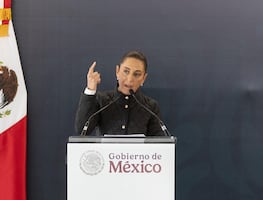Más Información

“Vamos a dar apoyo a los pequeños agricultores por sequía en Sonora”; Claudia Sheinbaum instruye a Berdegué

Derrota de México en disputa por maíz transgénico contra EU; estos son los argumentos de Sheinbaum y AMLO para prohibirlo

Óscar Rentería Schazarino, ha operado contra CJNG, Viagras y Templarios; es el nuevo secretario de Seguridad en Sinaloa

Claudia Sheinbaum pide respeto para Maru Campos; gobernadora anuncia acuerdo para transporte público

Claudia Sheinbaum anuncia los Centros de Cuidado Infantil en Chihuahua; inaugura hospital en Ciudad Juárez
Deputy Health Minister Hugo López-Gatell
informed that within 15 days – by late March – Mexico could enter the second stage , community transmission, with which there could be hundreds of COVID-19 coronavirus cases which would need different control measures.
During President Andrés Manuel López Obrador’s morning news conference, López-Gatell asserted that there should be no concerns for Mexico has few confirmed cases whereas the United States has over 1,000.
“This is the reality and these are the dates; the very moment and minute we detect we have entered the community transmission , we will inform it.”
Recommended: COVID-19: How to prevent coronavirus?

He asserted that the second stage will need public health measures such as school and work filters. This consists, according to López-Gatell of having people with minimum training focused on asking for symptoms like fever and coughing at the entrance of schools and works. If they detect people with respiratory disease symptoms , they will be asked to go back home.
López-Gatell asserted that for now, Mexico remains on stage one , with few imported cases ; nevertheless, international airports receiving flights from China or from the 10 countries with active COVID-19 transmission will experience intensified screening through the monitoring of passengers’ temperature and other symptoms.
About the U.S. government’s decision to suspend flights from Europe except for the UK as a health protection measure, López-Gatell said that Mexico is a sovereign state and that there are no current plans to restrict international travel nor close borders or maritime posts.
Recommended: The fatal results of the 1918 Spanish flu pandemic in Mexico
“These measures do not have a solid scientific base; in the whole history of pandemics there is no scientific evidence that these extreme measures could help reduce the risk of transmission and they don’t help either because they have serious economic and social consequences.”
He explained that Mexico’s government has a list of 8,000 public events in public spaces that are being analyzed to determine which could be postponed so as not to affect the economic activity.
Meanwhile, a Mexican scientist has forecast that coronavirus will enter the community transmission stage between March 20 and 30 .
In Spring 2009 , during the H1N1 virus crisis in Mexico City, Gustavo Cruz , a scientist from the National Autonomous University of Mexico , collaborated in the design of a mathematics model to determine the speed of infection.
Recommended: Looking back at Mexico's H1N1 virus pandemic
Since then, he was able to determine the date in which the cases would be registered and the efficiency of control measures implemented back then.
According to the UNAM , the member of the Applied Mathematics and Systems Research Institute (IIMAS) mentions that, although COVID-19 has already arrived in Mexico, it will be within two or three weeks when the number of infections rises exponentially.
“The base of this work is a classic model from 1927 developed by the Scottish doctors W.O. Kermack and A.G. McKendrick , which uses a system of differential equations so as to detail how an outbreak develops, grows , and the moment in which it reaches its peak and how it fall , all of it based on two parameters: one of them biological and the other social . In these cases, we have complemented these differential equations with classic diffusion to create was is called a reaction-diffusion system,” he said.
For every person that gets sick, all the possible people infected must be calculated. This is the basic reproductive number R0 .
Recommended: Mexico to keep airports open despite coronavirus pandemic
He explained that the R0 is a measure of how fast the outbreak spreads in a population during its initial stage and how it is quite useful when it comes to evaluating the size of the problem.
There are people who calculate that the R0 of this new coronavirus could go from 1.5 to 4 , which poses a very big range, although from what has been seen in Wuhan , the figure is calculated at 2.5 .
“For comparison, let’s say that the R0 of the H1N1 virus was 1.7 , which gives us a glimpse of what we could be facing soon.”
Recommended: World markets pummel amidst coronavirus fears and falling oil prices
mp





